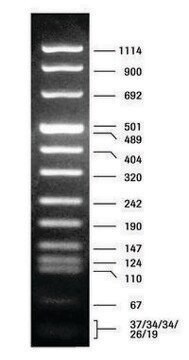L9516
Lipopolysaccharides (rough strains) from Salmonella enterica serotype typhimurium SL1181
Synonym(s):
LPS
Sign Into View Organizational & Contract Pricing
All Photos(1)
About This Item
MDL number:
UNSPSC Code:
12352201
Recommended Products
biological source
Salmonella enterica (Serotype typhimurium SL1181)
form
lyophilized powder
impurities
≤5% Protein (Lowry)
shipped in
ambient
storage temp.
2-8°C
General description
This product is phenol:chloroform:petroleum ether extracted from Salmonella typhimurium strain SL1181. The source strain is from a private collection. This LPS has been used as a negative control for antibody binding to LPS.
Biochem/physiol Actions
Lipopolysaccharides (LPS) are localized in the outer layer of the membrane and are, in noncapsulated strains, exposed on the cell surface. They contribute to the integrity of the outer membrane, and protect the cell against the action of bile salts and lipophilic antibiotics.
Preparation Note
Prepared by phenol-chloroform-petroleum ether extraction.
The product is soluble in water (5 mg/ml) or cell culture medium (1 mg/ml) yielding a hazy, faint yellow solution. A more concentrated, though still hazy, solution (20 mg/ml) has been achieved in aqueous saline after vortexing and warming to 70-80 oC. Lipopolysaccharides are molecules that form micelles in every solvent. Hazy solutions are observed in water and phosphate buffered saline. Organic solvents do not give clearer solutions. Methanol yields a turbid suspension with floaters, while water yields a homogeneously hazy solution.
The product is soluble in water (5 mg/ml) or cell culture medium (1 mg/ml) yielding a hazy, faint yellow solution. A more concentrated, though still hazy, solution (20 mg/ml) has been achieved in aqueous saline after vortexing and warming to 70-80 oC. Lipopolysaccharides are molecules that form micelles in every solvent. Hazy solutions are observed in water and phosphate buffered saline. Organic solvents do not give clearer solutions. Methanol yields a turbid suspension with floaters, while water yields a homogeneously hazy solution.
Other Notes
To gain a comprehensive understanding of our extensive range of Lipopolysaccharides for your research, we encourage you to visit our Carbohydrates Category page.
related product
Product No.
Description
Pricing
Storage Class Code
13 - Non Combustible Solids
WGK
WGK 3
Flash Point(F)
Not applicable
Flash Point(C)
Not applicable
Personal Protective Equipment
dust mask type N95 (US), Eyeshields, Gloves
Choose from one of the most recent versions:
Already Own This Product?
Find documentation for the products that you have recently purchased in the Document Library.
Customers Also Viewed
Anthony R Geonnotti et al.
AIDS research and human retroviruses, 26(3), 279-291 (2010-03-12)
Bacterial lipopolysaccharide (endotoxin) is a frequent contaminant of biological specimens and is also known to be a potent inducer of beta-chemokines and other soluble factors that inhibit HIV-1 infection in vitro. Though lipopolysaccharide (LPS) has been shown to stimulate the
Revathi Shanmugasundaram et al.
Poultry science, 98(3), 1127-1133 (2018-10-17)
This study was conducted to identify the effects of 25-OH cholecalciferol supplementation to turkeys on the immune cells parameters, fecal coccidial oocyst shedding, macrophage nitric oxide production, T regulatory cell cytokine production, and production parameters during a coccidial challenge. A
Aurélie Le Page et al.
Journal of Alzheimer's disease : JAD, 60(1), 23-42 (2017-08-05)
The mechanisms of neurodegeneration in Alzheimer's disease (AD) remain under investigation. Alterations in the blood-brain barrier facilitate exchange of inflammatory mediators and immune cells between the brain and the periphery in AD. Here, we report analysis of phenotype and functions
Sandra Jansen et al.
Infection and immunity, 81(5), 1788-1797 (2013-03-13)
The expression and function of psoriasin in the brain have been insufficiently characterized. Here, we show the induction of psoriasin expression in the central nervous system (CNS) after bacterial and viral stimulation. We used a pneumococcal meningitis in vivo model
Our team of scientists has experience in all areas of research including Life Science, Material Science, Chemical Synthesis, Chromatography, Analytical and many others.
Contact Technical Service




